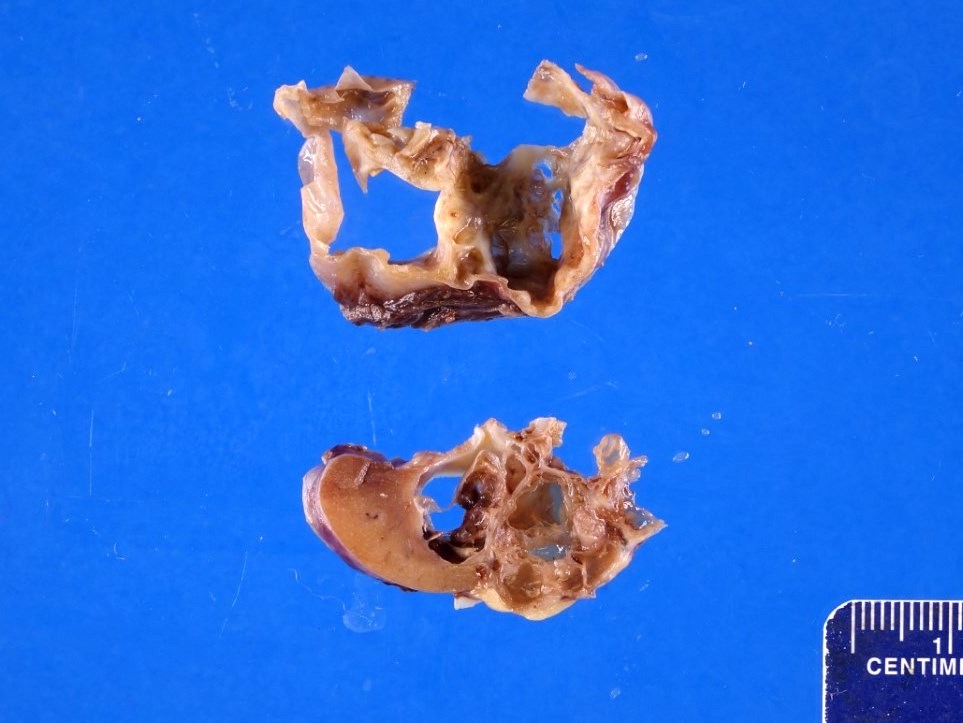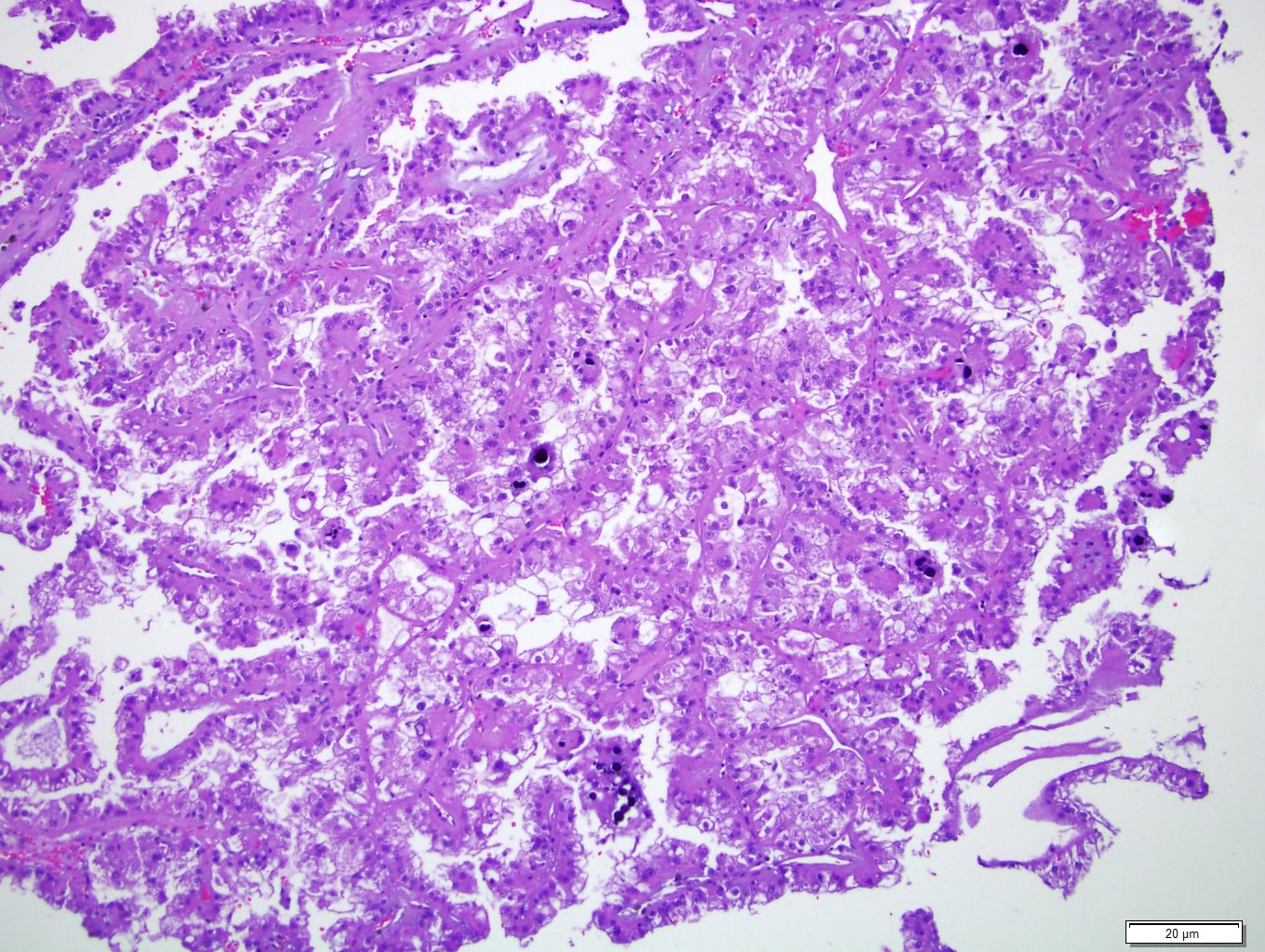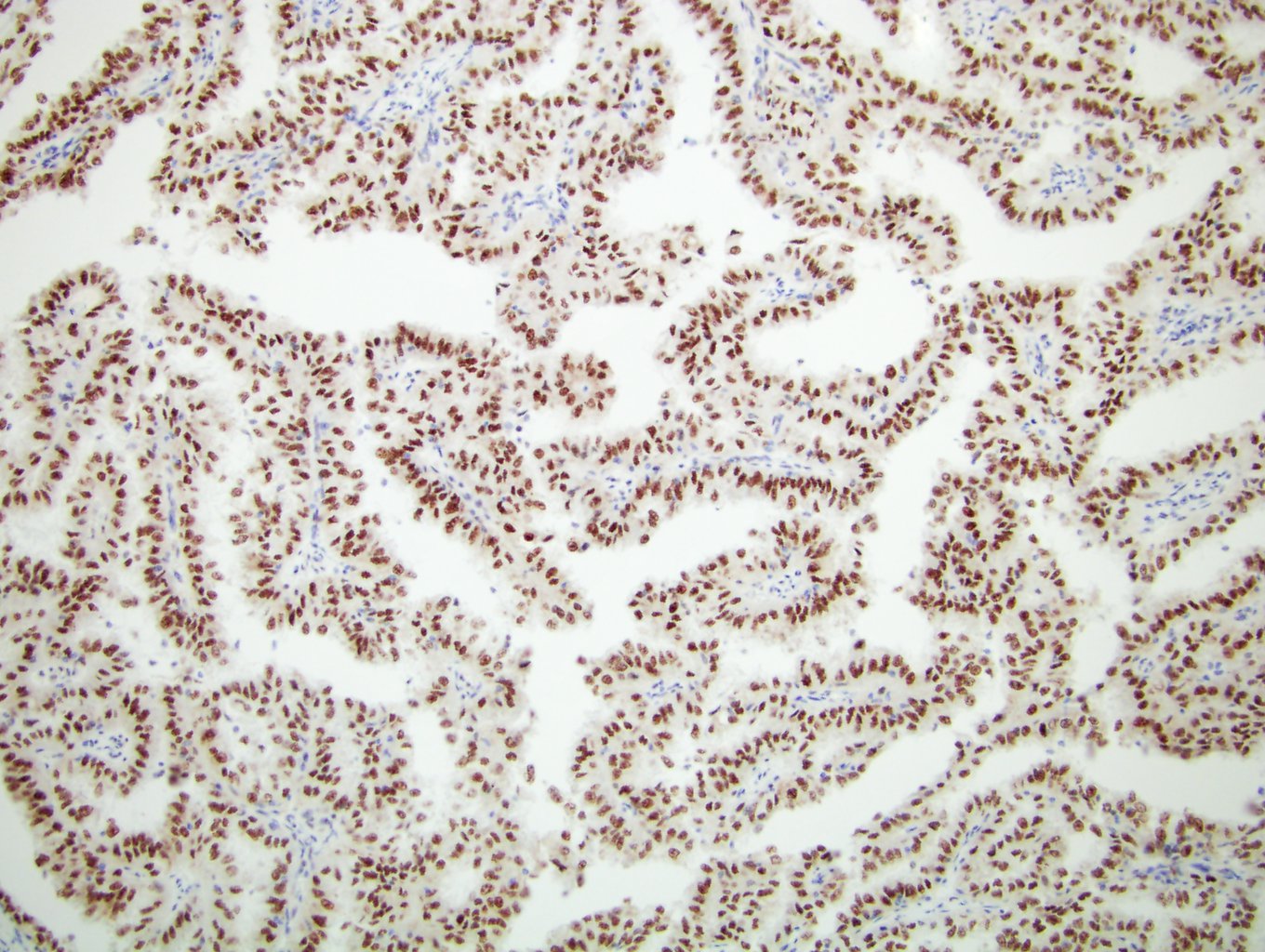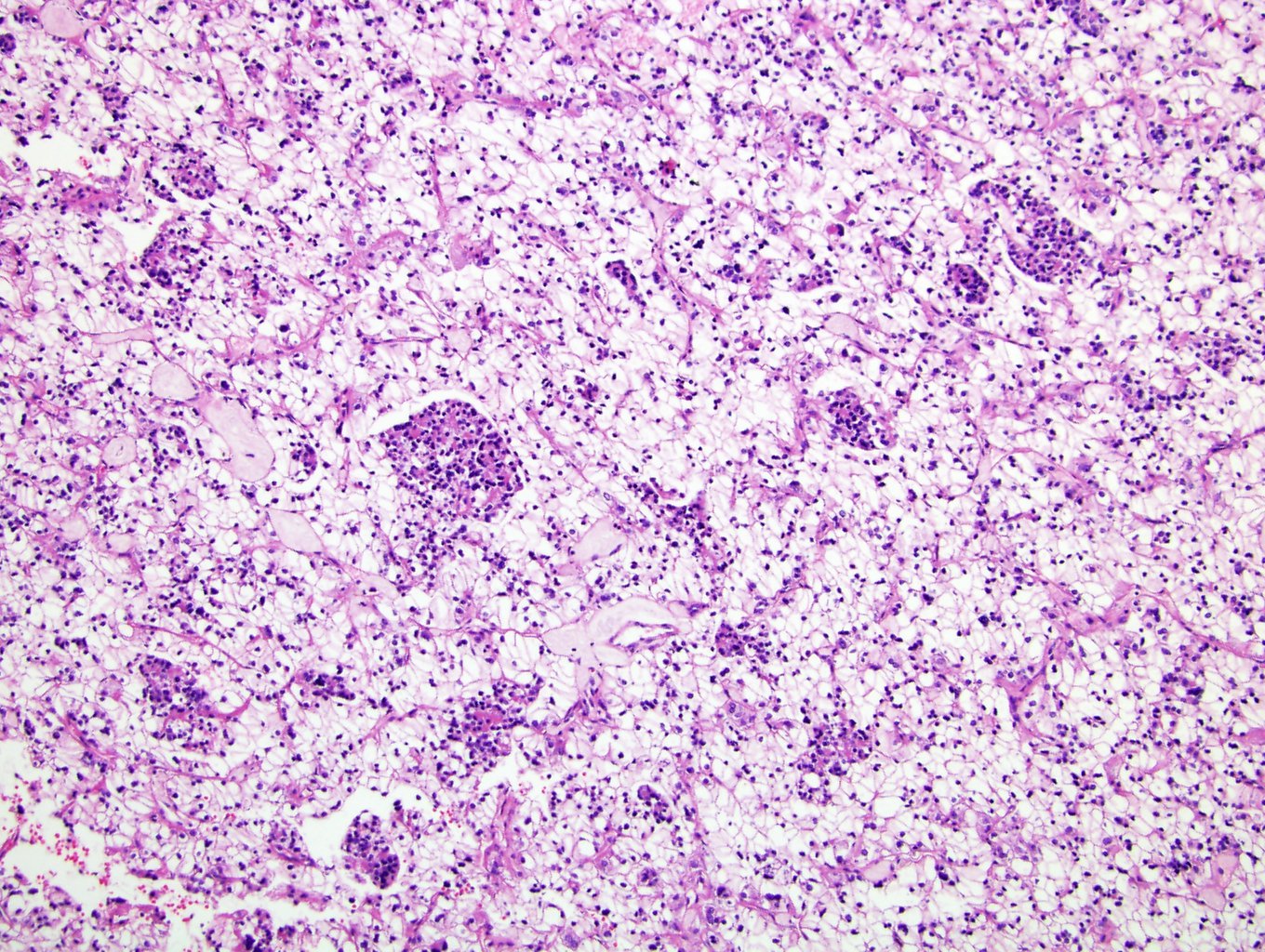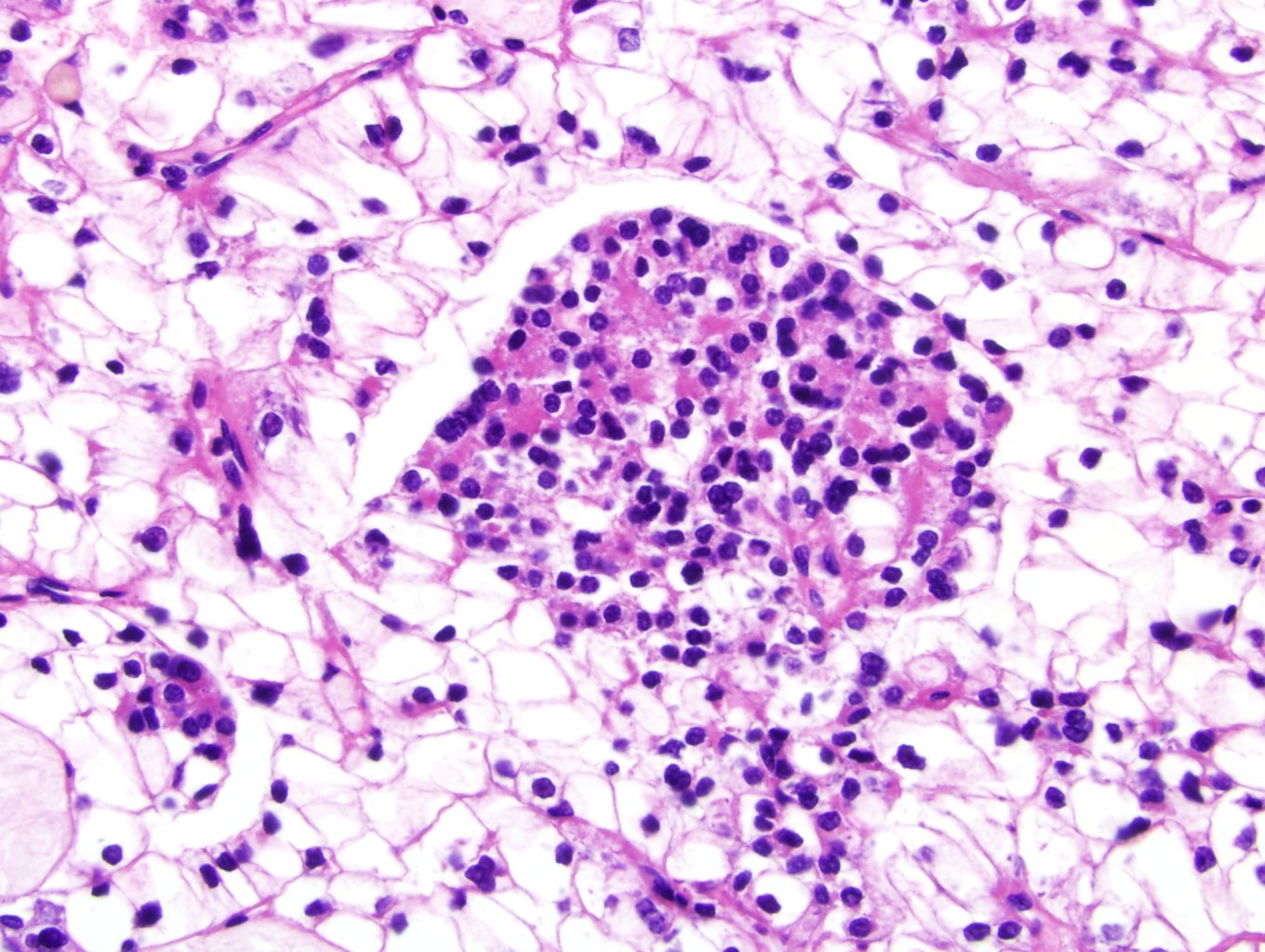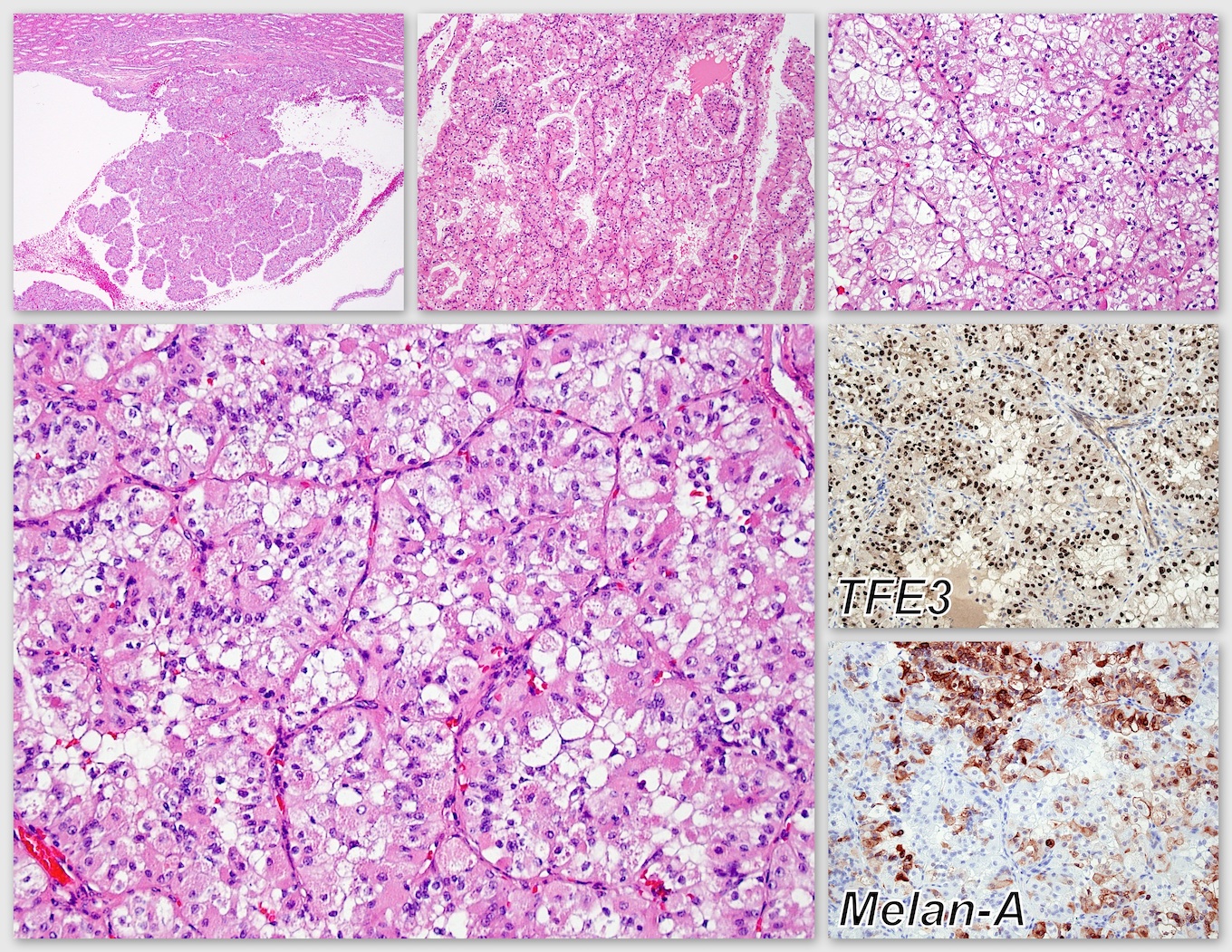Table of Contents
Definition / general | Essential features | Terminology | Epidemiology | Sites | Pathophysiology | Clinical features | Prognostic factors | Case reports | Treatment | Gross description | Gross images | Microscopic (histologic) description | Microscopic (histologic) images | Positive stains | Negative stains | IHC panels | Electron microscopy description | Molecular / cytogenetics description | Differential diagnosisCite this page: Andeen NK, Tretiakova M. MiT family translocation renal cell carcinomas. PathologyOutlines.com website. https://www.pathologyoutlines.com/topic/kidneytumormalignantASPLTFE3.html. Accessed April 25th, 2024.
Definition / general
- Harbor gene fusions involving members of the MiT family of transcription factors, including TFE3 and TFEB
- Histologically diverse, often have papillary, alveolar and nested growth pattern with clear and eosinophilic cells and psammoma bodies
- More common in children / young adults
Essential features
- Papillary with clear and eosinophilic cells but wide morphologic spectrum
- Diagnosis often relies on IHC or FISH for translocation (Am J Clin Pathol 2012;137:761)
Terminology
- Renal cell carcinomas / RCCs associated with Xp11 translocations have gene fusions involving TFE3, which has multiple gene partners; RCCs with t(6:11) translocations have MALAT1-TFEB gene fusions
- MiT refers to microphthalmia associated transcription factors
Epidemiology
- 3% of adult renal cell carcinomas (Clin Cancer Res 2009;15:1170)
- 19 of 46 (40%) of renal cell carcinomas in children/young adults were TFE3+ vs. 1.6% - 4% of adult RCCs (Int J Surg Pathol 2011;19:170)
- Exposure to cytotoxic chemotherapy is a risk factor (Semin Diagn Pathol 2015;32:103)
Sites
- Kidney
Pathophysiology
- Overexpression of TFE3 or TFEB activates multiple downstream targets, including those normally activated by MiT family transcriptions factors; thus often expresses the cysteine protease cathepsin K, may express melanocytic markers and is less likely to express epithelial markers like cytokeratins
Clinical features
- In adults, strong female predominance (22 of 28 cases in one series), usually age 35 or less, usually high stage at diagnosis (Am J Surg Pathol 2007;31:1149)
Prognostic factors
- Aggressive clinical course (Am J Clin Pathol 2007;128:70)
- t(6;11)(p21;q12) appears to have low malignant potential in contrast to other translocation carcinomas (Am J Surg Pathol 2005;29:230, Int Urol Nephrol 2009;41:553)
Case reports
- 12 year old boy with nodal involvement at diagnosis (Afr J Paediatr Surg 2011;8:317)
- 20 year old woman with metastasis to placenta (Int J Surg Pathol 2011;19:80)
- Mini review with gross and radiographic images (SpringerPlus 2014;3:245)
Treatment
- Resection
- mTOR and tyrosine kinase inhibitors may be beneficial (Semin Diagn Pathol 2015;32:103)
- Selective MET inhibitors appear to have modest antitumural activity (Cancer 2012;118:5894)
Gross description
- Tan yellow, frequently hemorrhagic and necrotic; not distinct from other RCCs
Microscopic (histologic) description
- TFE3 rearranged carcinomas usually have papillary and solid alveolar growth pattern, composed of clear to eosinophilic discohesive pseudostratified cells with voluminous cytoplasm and high grade nuclei
- TFE3 rearranged carcinomas also frequently have psammoma bodies and may contain melanin pigment, similar to a pigmented perivascular epithelioid tumor (PEC)oma (Semin Diagn Pathol 2015;32:103)
- t(6:11) rearranged carcinomas are characteristically biphasic, with small cells clustered around basement membrane material (reminiscent of Call-Exner bodies in adult granulosa cell tumor) and larger epithelioid cells (Semin Diagn Pathol 2015;32:103)
Microscopic (histologic) images
Contributed by Nicole K. Andeen, M.D.
Positive stains
- TFE3 or TFEB (strong nuclear staining), PAX8, cathepsin K, CD10, AMACR, vimentin, E-cadherin
- May express melanocytic markers HMB45 and MelanA, more commonly in t(6:11) carcinomas and infrequently in Xp11 (WHO 2016; Semin Diagn Pathol 2015;32:103)
- Weak TFE3 staining in adults may not be specific (Am J Surg Pathol 2012;36:654)
Negative stains
- Variable cytokeratin (only 30% - 50% positive, less than other RCC types) and EMA (50%, frequently only focal) (Am J Surg Pathol 2002;26:1553, Am J Surg Pathol 2008;32:656, Am J Surg Pathol 2010;34:1295)
- Carbonic anhydrase / CAIX usually negative except areas of necrosis (Am J Clin Pathol 2010;134:873)
- CD45, calretinin, smooth muscle actin
IHC panels
| Hale | KIT | CK7 | S100A1 | VIM | CAIX | AMACR | SDH | TFE3 | |
| Chromophobe RCC | +++ | +++ | +++ | - | - | - | - | +++ | - |
| Clear cell RCC | - | - | - | - | +++ | +++ | - | +++ | - |
| Oncocytoma | - | +++ | rare | +++ | - | - | - | +++ | - |
| Papillary RCC | - | - | +++ | - | +++ | - | +++ | +++ | - |
| Translocation RCC | - | - | - | - | - | - | ++ | +++ | +++ |
| SDH deficient RCC | - | - | - | - | - | - | - | - | - |
References: Pathol Res Pract 2015;211:303, Ann Diagn Pathol 2020;44:151448, Am J Surg Pathol 2014;38:e6, Arch Pathol Lab Med 2019;143:1455, Transl Androl Urol 2019;8:S123, Hum Pathol 2020 Jul 13 [Epub ahead of print]
Electron microscopy description
- Features of clear cell carcinoma, including cell junctions, numerous mitochondria, microvilli, basement membrane, abundant glycogen
Molecular / cytogenetics description
- Fluorescence in situ hybridization (FISH) with a TFE3 or TFEB breakapart probe is highly sensitive and specific; it is diagnostic when indeterminate by morphology and immunohistochemistry
- TFE3 (on Xp11) has been reported with multiple gene partners, including the two most common, ASPL (17q25) and PRCC (1q21), and less commonly NONO (Xq12), PSF/SFPQ (1p34), CLTC (17q23) (WHO 2016, Am J Surg Pathol 2007;31:1149, Expert Rev Anticancer Ther 2010;10:843)
- t(6;11)(p21;q12): translocation between TFEB and MALAT1 genes result in overexpression of TFEB
- t(X;17)(p11.2;q25), with balanced translocation of TFE3 gene at Xp11.2 and ASPL gene at 17q25, is present in renal neoplasms, whereas in alveolar soft part sarcoma, this translocation is unbalanced, der(17)t(X;17)(p11.2;q25) (Am J Pathol 2001;159:179)
- Melanotic Xp11 renal cell carcinoma and PSF/SFPQ-TFE3 perivascular epithelioid cell tumors may share the same genetic abnormality and may be in the same clinicopathologic spectrum (Am J Surg Pathol 2015;39:1181)
Differential diagnosis
- Clear cell papillary renal cell carcinoma: typically a homogeneous low grade population of clear cells without eosinophilic cells, no calcifications, often branched ductular structures, secretory cells with nuclei aligned above basement membrane (resembling secretory endometrium); CK7+, CAIX+, CD10-, AMACR-
- Clear cell renal cell carcinoma: older patients, no true papillae (although pseudopapillary areas due to poor cell cohesion can be seen in high grade clear cell RCC); frequently keratin / EMA+, vimentin+, TFE3-, diffuse CAIX+, 3p deletion present
- Epithelioid angiomyolipoma: always negative for PAX8
- Chromophobe renal cell carcinoma: diffuse CD117 staining favors chromophobe
- Papillary renal cell carcinoma: predominantly papillary, no nested alveolar patterns, no extensive areas of clear cells; CK7+, TFE3-, trisomy 7 and 17





